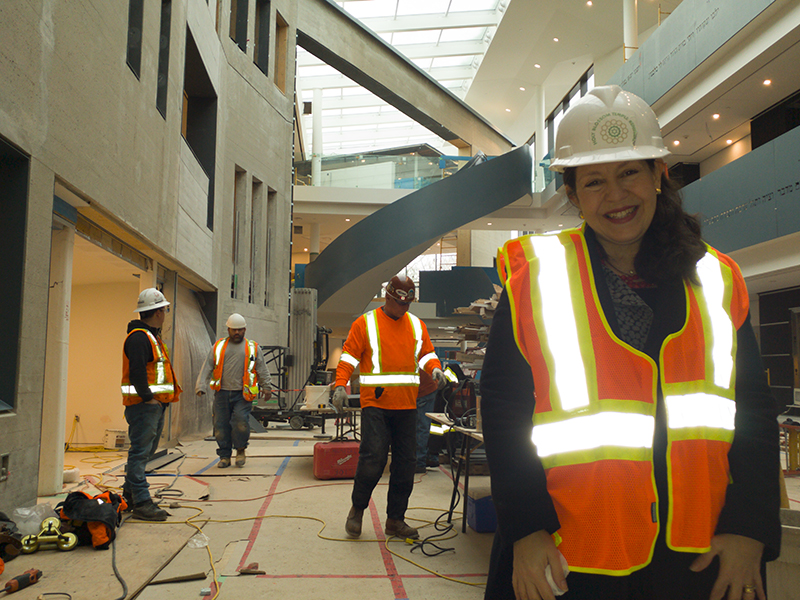For a visitor who doesn’t know the difference between drywall and particle board, it looks like the construction work at Toronto’s Holy Blossom Temple still has a ways to go.
Workmen in hard hats and reflective vests mill about the place in large numbers. Four big guys stride into the atrium, the centrepiece of the renovation, labouring under a massive panel of some sort.
The concrete floor is covered in dust. Only a few of the 12 stone slabs that are symbolic of the ancient tribes of Israel are in place in the atrium. When completed, they will mark a havdalah between the profane space of the prospective meeting area and the holy area of the sanctuary.
A number of rooms off the atrium are still under construction and both the north and south parking lots are reserved for the construction crew and the materials they need to complete the shul’s $32.9-million renovation.
READ: NEW CEMETERY FOR INTERFAITH COUPLES OPENS IN THE GTA
Still, on Dec. 2, Holy Blossom Temple will dedicate the new facility before congregants and well-wishers.
The date coincides with the festival of Hanukkah, which marks the dedication of the Temple in Jerusalem after it had been recaptured by the Maccabees in 165 BCE.
About two years in the making, the current renovation will make Holy Blossom Temple even more member-friendly, while providing new spaces to bring together the congregation of worshippers and strengthen the feeling of community, said Rabbi Yael Splansky.
Rabbi Splansky, who delights in showing visitors around the construction site, while wearing her “senior rabbi” hardhat and reflective vest, is clearly quite proud of the vision embodied in the soon-to-be upgraded house of worship.

The new space will be a beit knesset, or meeting area, that brings together the beit midrash, the synagogue’s learning centre, with the beit tefillah, or house of prayer, she said.
In her mind’s eye, she sees the meeting rooms, archives, boardroom, classes and other facilities, but to the amateur observer, it looks like a lot of work still has to be done before the facility can be put to use.
According to Tom Friedland, who chairs the synagogue’s steering committee, the work should be completed within a couple of weeks of the Dec. 2 dedication.
Even with the hustle and bustle of workmen going about their tasks, along with the clutter that accompanies it, it is clear that the space, when it is completed, will be spectacular. The atrium, the centrepiece of the building, will soar three stories. One of its walls will be decorated with live plants. A spiral staircase serving four floors adds drama to the setting.
“This is what we call a game-changer,” enthused Rabbi Splansky. “I like to call it the living room of the congregation, where people will meet, stay late, get engaged (with one another).”
A cafe will be located in one of the rooms off the atrium, meant to entice members of the congregation to gather before and after events and get to know one another, Rabbi Splansky explained.
There will be an area for musical recitals, with Tuesdays set aside for talent night, to showcase the musical abilities of members of the congregation, she said.
An archive area will showcase memorabilia from the synagogue, which date back to 1856, when the first iteration of the synagogue was launched. Central to the archive is a yad, a ceremonial pointer used when reading the Torah, which was inscribed at the time with the wish that the synagogue should flourish like a holy blossom. That inspired the naming of the synagogue, Rabbi Splansky said.
This is what we call a game-changer.
– Rabbi Yael Splansky
The yad will be on public display when the renovation is complete, embedded in a backlit onyx wall that serves as the back to the main sanctuary’s ark, facing towards the atrium.
So far, $29 million of the $32.9 million cost of Phase 1 of the renovation has been raised. Rabbi Splansky said she expects no problems raising the remaining sum. At any rate, membership fees have not been affected by the project, though she acknowledges that because of the disruption, the shul has hosted fewer major life-cycle events.
Friedland said that renovations like this happen once in a generation: the last one took place in 1960; the one before that in 1938.
The changes are meant to make the synagogue a real showcase, one that both its members and the broader community can feel pride in.
“If you want to be best in class, if you want to maintain and attract membership, you need these best-in-class components,’ Friedland said.
